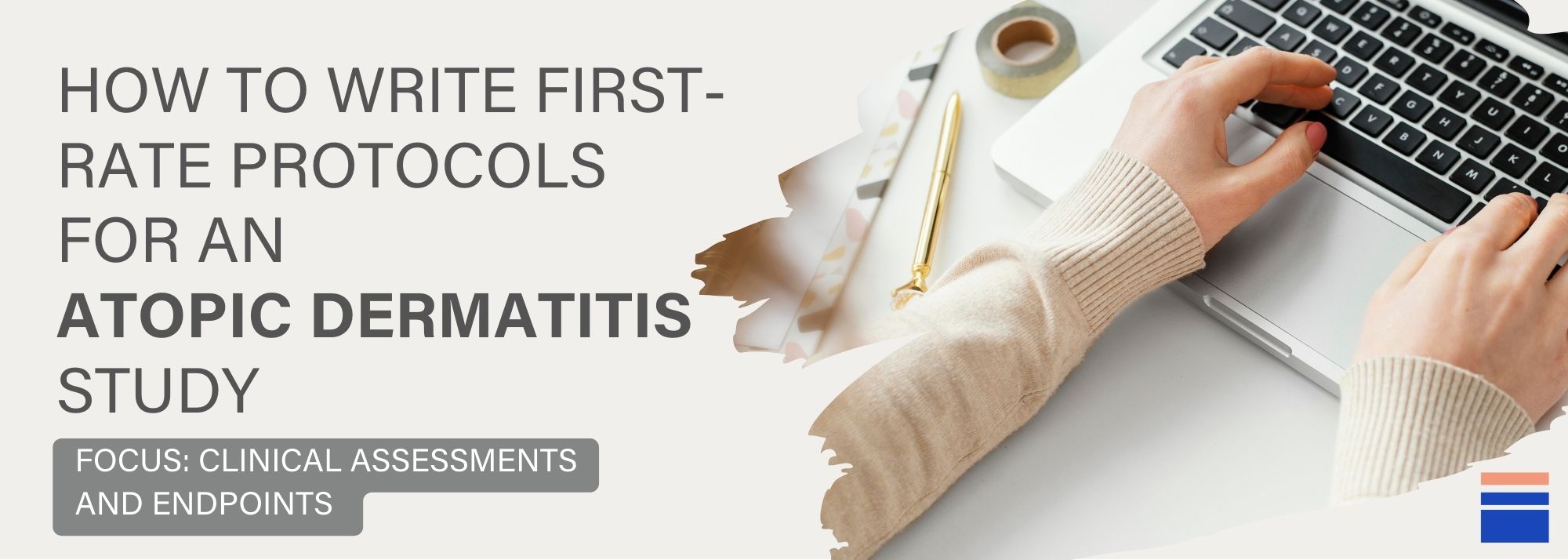How to Write First-Rate Protocols for an Atopic Dermatitis Study - Focus: CLINICAL ASSESSMENTS AND ENDPOINTS

In recent years, therapeutics for dermatologic conditions have become a subspecialty of growing interest in the Clinical Research Organisation (CRO) industry, with clinical research in the area focused on a wide range of skin indications, such as acne vulgaris, psoriasis, and atopic dermatitis.
What is atopic dermatitis?
Atopic dermatitis (AD), also known as atopic eczema, is the most common, long-term type of inflammatory skin disease. Stemming from skin barrier dysfunction, immune alterations, and/or genetic and environmental factors, the condition may occur at any age but usually starts in childhood.
Clinical assessments
Clinical evaluations may include global AD severity assessments, such as the Body Surface Area (BSA), Eczema Area and Severity Index (EASI), and Investigator Global Assessment (IGA). If the drug is intended to be marketed in Europe, the SCORing Atopic Dermatitis tool (SCORAD) should also be evaluated. For intraindividual studies, AD lesion severity evaluations should be included, such as lesion IGA, Target Area Assessment (TAA), or Total Lesion Severity Score (TLSS). It is also important to follow previous U.S. Food and Drug Administration (FDA) approvals for selection of the appropriate assessments/primary endpoints for trials supporting new drug applications in AD, such as the proportion of subjects achieving a vIGA-AD of 0/1 with ≥2-point decrease from baseline.
Patient quality of life and itch
In all phases of development, it is advised to evaluate quality of life (QoL) and the patient’s perspective of efficacy using validated instruments. One of the most frequently used scales in AD trials is the pruritus numeric rating scale (NRS). Based on our experience, there are several key elements to consider with this type of scale, including:
- Recall period (24 hours vs previous week)
- Severity (worst vs average)
- Frequency of evaluation
- Itch NRS scores should begin to be captured several days before baseline.
- Itch should be evaluated daily but the weekly average should be the final output.
Pharmacodynamic evaluations
Various pharmacodynamic assessments, such as tape stripping, biopsy collection, and transepidermal water loss can also be planned; however, sponsors should be mindful of the burden that these may place on patients.
Endpoint summary
Ultimately, the study endpoints are determined based on the study phase, the study design, and the planned study evaluations.
In proof-of-concept (POC) and Phase 2 studies, the efficacy endpoint that is the most sensitive or has the greatest power to detect a difference between treatment groups should be selected.
In a meta-analysis that was recently published, continuous instruments such as the EASI, IGA, and BSA, used in topical clinical trials for AD had significantly higher sensitivity when compared to dichotomous endpoints. Therefore, continuous efficacy measures are recommended since they provide more power for POC trials with a small sample size in AD involving topical therapies.
In Phase 3 studies, the protocol should be aligned as much as possible with the requirements of regulatory agencies.
Conclusion
When writing an AD protocol, you must not only have a solid understanding of the indication and what you are measuring, but also keep abreast of related literature. Be it procedures for a study on AD or another skin indication, the best protocols in dermatology are often the simplest, with the goal of bridging a knowledge gap or highlighting something new in the field. Resulting from a strong collaborative effort, a first-rate protocol not only provides a roadmap for better enrollment rates and data quality, but also allows investigators to remain at the forefront of dermatology research.
About the Author
Stéphanie Légaré is a senior clinical scientist at Innovaderm with >10 years’ experience in scientific and medical communication and translational/clinical research. Throughout her career, she has managed several investigator-initiated studies and developed training materials for pharmaceutical and life sciences companies.
✨ To learn best tips for writing about study design for research on AD, click here.
✨ To learn best tips for writing about treatment duration and key eligibility criteria for a study on AD, click here.
✨ For more great tips, watch our webinar on the Art of Protocol Writing in Dermatology.
***
Want to ensure your study is a great success? Contact us today to partner with our expert team of clinical trial professionals.
Newsletter
Newsletter subscription resources

